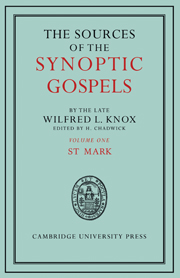Book contents
- Frontmatter
- Dedication
- Contents
- EDITOR'S PREFACE
- PREFACE
- ABBREVIATIONS
- INTRODUCTION
- I The first group of conflict-stories
- II The Twelve-source
- III Jesus and the devils
- IV The book of parables
- V Books of miracles
- VI Nazareth and John the Baptist
- VII Corban and miscellaneous incidents
- VIII A book of localized miracles
- IX The ‘Central Section’
- X The entry to Jerusalem
- XI A second group of conflict-stories?
- XII The warning against the scribes
- XIII The ‘Little Apocalypse’
- XIV The Passion story
- XV The Resurrection story
- SUMMARY
- INDEXES
XV - The Resurrection story
Published online by Cambridge University Press: 05 July 2014
- Frontmatter
- Dedication
- Contents
- EDITOR'S PREFACE
- PREFACE
- ABBREVIATIONS
- INTRODUCTION
- I The first group of conflict-stories
- II The Twelve-source
- III Jesus and the devils
- IV The book of parables
- V Books of miracles
- VI Nazareth and John the Baptist
- VII Corban and miscellaneous incidents
- VIII A book of localized miracles
- IX The ‘Central Section’
- X The entry to Jerusalem
- XI A second group of conflict-stories?
- XII The warning against the scribes
- XIII The ‘Little Apocalypse’
- XIV The Passion story
- XV The Resurrection story
- SUMMARY
- INDEXES
Summary
The loss of Mark's ending leaves us with little guidance as to the sources from which the existing narratives of the Resurrection appearances are drawn. None the less it is worth noting that in I Cor. XV. 5 the story begins with an appearance to Cephas followed by an appearance to ‘the Twelve’ (only here in Paul). In Luke xxiv. 34 the two disciples returning from Emmaus find ‘the eleven’ assembled and are greeted with the news that the Lord has risen and appeared to Simon.
The Emmaus story has every appearance of having been largely edited by Luke. xxiv. 19—21 is a specimen of the apostolic kerygma of the crucifixion and resurrection, the latter being naturally left in suspense to suit the real or supposed situation of the moment; the claim that this is the fulfilment of prophecy in 26 f. is again part of the kerygma, though on grounds of dramatic propriety it is put into the mouth of the risen Lord and thus comes after the story of the ministry and death. But ‘ there seems to be no good reason why the story should not be founded on fact’ (Creed, p. 290). If so, it is possible that this story of an appearance in the neighbourhood of Jerusalem has been put by Luke before the story of an appearance to Simon and to the eleven, drawn from the same source as the Pauline summary, which may well have been the conclusion of the Twelve-source.
- Type
- Chapter
- Information
- The Sources of the Synoptic Gospels , pp. 148 - 149Publisher: Cambridge University PressPrint publication year: 2011

